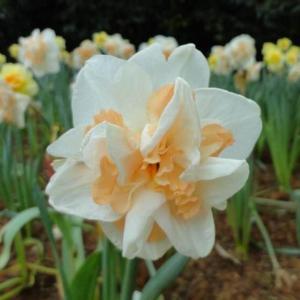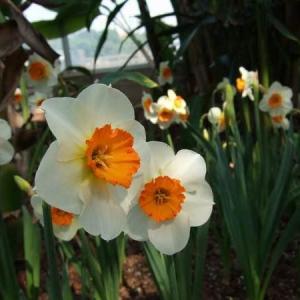文章
A🎌王木木💮
2019年11月21日

Everything withered in the cold winter,give a feeling of loneliness.If there are still flowers blooming on the balcony,is spring not far from us?Today we are going to introduce the daffodils that are suitable for growing in winter.
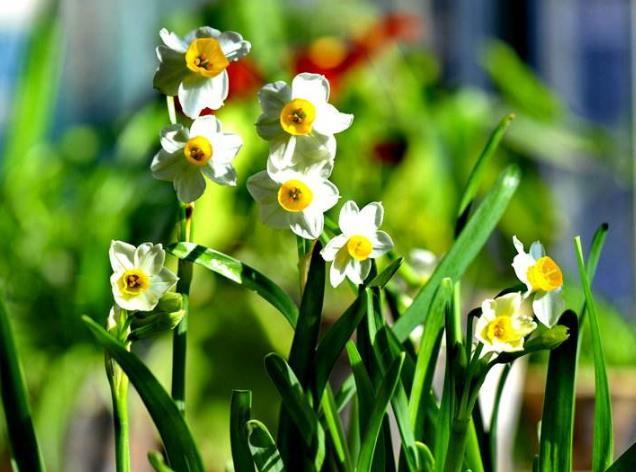
Other common names:daffodil 'Nessa'
Family:Amaryllidaceae
Genus:Narcissus are bulbous herbaceous perennials with linear leaves and leafless stems bearing flowers, which may be solitary or in umbels, with 6 spreading perianth segments and a cup or trumpet-shaped corona
Horticultural Group:Jonquilla and Apodanthus daffodils have very narrow cylindrical leaves and stems with up to 5, usually fragrant, flowers per stem, with spreading perianth segments and a small cup
Details:'Nessa' is a Jonquilla daffodil producing 1-3, strongly scented flowers on each stem in mid-spring. Each 6cm flower comprises yellow, overlapping outer petals surrounding a deeply-ribbed and lightly-frilled, bowl-shaped, orange corona
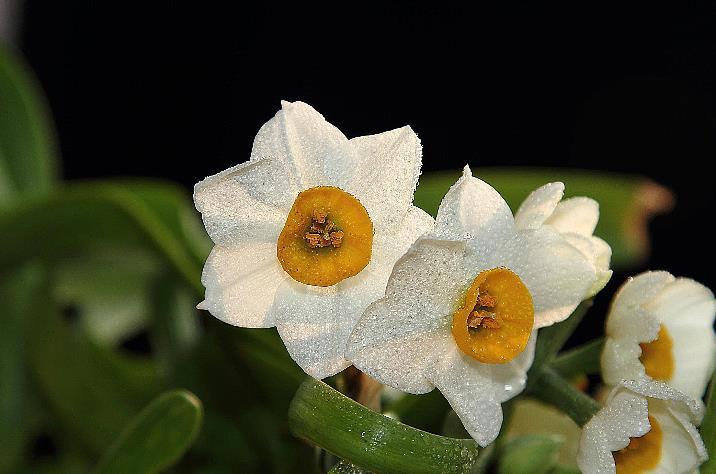
How to grow
Cultivation Plant at one and a half to two times its own depth in autumn. Will tolerate most soils but prefers moderately fertile, well-drained soil that is constantly moist during the growing season. See daffodil cultivation for further advice
Propagation Propagate by removing offsets as the leaves fade in early summer
Suggested planting locations and garden types Flower borders and beds Cut Flowers Low Maintenance City & Courtyard Gardens Cottage & Informal Garden Patio & Container Plants Wildflower meadow

How to care
PruningDeadhead after flowering and allow the leaves to die down naturally
Pests Susceptible to slugs, narcissus bulb fly, narcissus eelworm, and bulb scale mite
Diseases May be affected by narcissus basal rot, narcissus leaf scorch or daffodil viruses

Other common names:daffodil 'Nessa'
Family:Amaryllidaceae
Genus:Narcissus are bulbous herbaceous perennials with linear leaves and leafless stems bearing flowers, which may be solitary or in umbels, with 6 spreading perianth segments and a cup or trumpet-shaped corona
Horticultural Group:Jonquilla and Apodanthus daffodils have very narrow cylindrical leaves and stems with up to 5, usually fragrant, flowers per stem, with spreading perianth segments and a small cup
Details:'Nessa' is a Jonquilla daffodil producing 1-3, strongly scented flowers on each stem in mid-spring. Each 6cm flower comprises yellow, overlapping outer petals surrounding a deeply-ribbed and lightly-frilled, bowl-shaped, orange corona

How to grow
Cultivation Plant at one and a half to two times its own depth in autumn. Will tolerate most soils but prefers moderately fertile, well-drained soil that is constantly moist during the growing season. See daffodil cultivation for further advice
Propagation Propagate by removing offsets as the leaves fade in early summer
Suggested planting locations and garden types Flower borders and beds Cut Flowers Low Maintenance City & Courtyard Gardens Cottage & Informal Garden Patio & Container Plants Wildflower meadow

How to care
PruningDeadhead after flowering and allow the leaves to die down naturally
Pests Susceptible to slugs, narcissus bulb fly, narcissus eelworm, and bulb scale mite
Diseases May be affected by narcissus basal rot, narcissus leaf scorch or daffodil viruses
0
0
文章
Miss Chen
2018年01月09日

For gardeners new to spring bulbs, daffodils (Narcissus spp.) are a bright gift. Hardy between U.S. Department of Agriculture plant hardiness zones 3 through 10, depending on species, daffodils are less appetizing to winter grazing rodents -- and more reliable perennials -- than many other spring bulbs. They come in a variety of forms and coloration. A well-chosen collection of early-, mid- and late-season varieties will brighten your garden throughout the spring.

Mystery of the Bulb
Daffodil bulbs, like other tunicate bulbs, wear a protective layer of dried skin, or tunic, that helps insulate and keep bulbs moist. The thick layers underneath the tunic anchor this year's plant but also contain the embryo of a succeeding plant, flower and all, and enough nutritious material to keep it healthy until it is time for it to bloom, hopefully next spring. The bulb protects the growing flower from heat, drought and freezing weather.
The bulb never stops growing. It adds layers and processes and stores nutrients year-round. This prepares its hardy little occupant for the vicissitudes of unpredictable spring weather. It might even pop up through the last melting snow if conditions are right.
The Right Conditions
Every daffodil has its own rhythm to follow. Growth responds to daylight and soil temperature. Daffodils come to life when soil temperatures range from 50 to 60 degrees Fahrenheit and as the sun rises and days lengthen. Each year brings a slightly different progression, so bloom times may vary by days or weeks from one year to another.

Early varieties such as February Gold (Narcissus 'February Gold,' USDA zones 4 to 8) and Ice Follies (Narcissus 'Ice Follies,' USDA zones 3 to 8) bloom, as their names suggest, as winter fades into very early spring. Tete-a-Tete (Narcissus 'Tete-a-Tete,' USDA zones 4 to 8) may bloom as early as February in warmer southern zones, but wait until March further north.
Mid-season begins in March in southern zones, but in cooler zones Jack Snipe (Narcissus 'Jack Snipe,' USDA zones 4 to 8), Trevithian (Narcissus 'Trevithian,' USDA zones 5 to 10) and many of the big mid-season trumpet "daffs" bloom throughout April.
Late varieties such as Salome (Narcissus 'Salome,' USDA zones 3 to 9) may bloom as late as mid-May in the north.
About Chilling
Many daffodils depend on winter chilling to keep their bloom time on track. They typically require temperatures between 35 and 48 degrees Fahrenheit for 12 to 18 weeks depending on variety -- not a problem for bulbs planted in fall in northern zones. Gardeners in USDA zone 8 and further south dig and dry bulbs with long chilling requirements after foliage dies down in summer and keep them in cool storage for three to four months before replanting. Gardeners in warmer zones can plant native daffodils such as tazetta daffodils (Narcissus 'Minnow,' USDA zones 5 through 9) that do not require lengthy chilling.
The Prolific Perennial
Daffodils are reliably perennial and will produce daughter bulbs along their bases. Separate these bulbs every two or three years after their foliage has died down in early summer. Just lay bulbs out in cool shade to dry. Pull off the daughter bulbs and plant them in sunny, well-drained soil come fall.

Mystery of the Bulb
Daffodil bulbs, like other tunicate bulbs, wear a protective layer of dried skin, or tunic, that helps insulate and keep bulbs moist. The thick layers underneath the tunic anchor this year's plant but also contain the embryo of a succeeding plant, flower and all, and enough nutritious material to keep it healthy until it is time for it to bloom, hopefully next spring. The bulb protects the growing flower from heat, drought and freezing weather.
The bulb never stops growing. It adds layers and processes and stores nutrients year-round. This prepares its hardy little occupant for the vicissitudes of unpredictable spring weather. It might even pop up through the last melting snow if conditions are right.
The Right Conditions
Every daffodil has its own rhythm to follow. Growth responds to daylight and soil temperature. Daffodils come to life when soil temperatures range from 50 to 60 degrees Fahrenheit and as the sun rises and days lengthen. Each year brings a slightly different progression, so bloom times may vary by days or weeks from one year to another.

Early varieties such as February Gold (Narcissus 'February Gold,' USDA zones 4 to 8) and Ice Follies (Narcissus 'Ice Follies,' USDA zones 3 to 8) bloom, as their names suggest, as winter fades into very early spring. Tete-a-Tete (Narcissus 'Tete-a-Tete,' USDA zones 4 to 8) may bloom as early as February in warmer southern zones, but wait until March further north.
Mid-season begins in March in southern zones, but in cooler zones Jack Snipe (Narcissus 'Jack Snipe,' USDA zones 4 to 8), Trevithian (Narcissus 'Trevithian,' USDA zones 5 to 10) and many of the big mid-season trumpet "daffs" bloom throughout April.
Late varieties such as Salome (Narcissus 'Salome,' USDA zones 3 to 9) may bloom as late as mid-May in the north.
About Chilling
Many daffodils depend on winter chilling to keep their bloom time on track. They typically require temperatures between 35 and 48 degrees Fahrenheit for 12 to 18 weeks depending on variety -- not a problem for bulbs planted in fall in northern zones. Gardeners in USDA zone 8 and further south dig and dry bulbs with long chilling requirements after foliage dies down in summer and keep them in cool storage for three to four months before replanting. Gardeners in warmer zones can plant native daffodils such as tazetta daffodils (Narcissus 'Minnow,' USDA zones 5 through 9) that do not require lengthy chilling.
The Prolific Perennial
Daffodils are reliably perennial and will produce daughter bulbs along their bases. Separate these bulbs every two or three years after their foliage has died down in early summer. Just lay bulbs out in cool shade to dry. Pull off the daughter bulbs and plant them in sunny, well-drained soil come fall.
0
0
文章
Miss Chen
2018年01月08日

Winter seems to slip into spring almost unseen some years. The north wind brings frost one day, and the next day tulips (Tulipa spp.) and daffodils (Narcissus spp.) are popping up. Too often, though, one last frost or even a few more inches of snow spoil a gardener's fun. Fear not: A light frost won't hurt tulip or daffodil plants. In fact, they need a bit of chilling to bloom their best.

Tough Spring Bulbs
Hardy spring bulbs such as tulips and daffodils survive frozen ground where air temperatures dip to minus 40 degrees Fahrenheit. Some other bulb plants even bloom through snow, leading the way in spring. Provided they are not in bloom, tulips and daffodils are tough enough to survive a few nights of light frost. A coating of snow may weight them down or break their emerging stems, but won't kill the bulbs. Tulips are hardy in U.S. Department of Agriculture plant hardiness zones 3 through 8, depending on type, and daffodils are hardy in USDA zones 4 through 8, depending on cultivar.
Survival Characteristic
Aside from their hardiness, tulip and daffodils share the common trait of growing from bulbs, which are modified roots adapted to protect and feed the plants in unpredictable periods of time, such as during extreme cold. Each bulb grows a layer of tissue as an embryonic plant, complete with flower.
As the days lengthen in spring and the ground thaws, the plants emerge from the bulbs on a schedule determined by evolution. Provided bulbs are planted under 6 to 8 inches of loamy soil and the soil remains moist but not soggy, the bulbs have the conditions necessary to emerge on a day when the environmental odds are in their favor.

Spring Companions
Tulips and daffodils are suitable companions in a spring garden. Both naturalize easily, growing in drifts. Early daffodils typically bloom before early tulips, providing up to two months of color beginning in March or April and ending in April or May, depending on the latitude.
Species tulips return year after year more easily than hybrids, and division adds longevity to daffodil bulbs, which tend to reproduce every three to five years. When the number of blooms declines, simply dig up the old bulbs and either plant new bulbs or divide the old bulbs, and store them when dry in a refrigerator until fall planting time.
Give your tulips and daffodils the best positions to minimize the effects of sudden spring frosts and freezes. Plant their bulbs on your home's north or east side, where sunlight doesn't heat the soil as fast as it does on south and west sides.
In Case of Extremes
Although tulips and daffodils are cold-tolerant, temperatures below 29 degrees Fahrenheit can damage their tender buds and flowers. An extended hard freeze can damage whole plants. Because next year's plants are forming within the bulbs, though, cold damage may be limited to this year's growth.
If a hard freeze is forecast after tulip and daffodil plants emerge above soil in spring, then cover the plants with a cloth sheet. Cloth insulates -- as long as it doesn't touch the plants -- and holds in ground warmth.

Tough Spring Bulbs
Hardy spring bulbs such as tulips and daffodils survive frozen ground where air temperatures dip to minus 40 degrees Fahrenheit. Some other bulb plants even bloom through snow, leading the way in spring. Provided they are not in bloom, tulips and daffodils are tough enough to survive a few nights of light frost. A coating of snow may weight them down or break their emerging stems, but won't kill the bulbs. Tulips are hardy in U.S. Department of Agriculture plant hardiness zones 3 through 8, depending on type, and daffodils are hardy in USDA zones 4 through 8, depending on cultivar.
Survival Characteristic
Aside from their hardiness, tulip and daffodils share the common trait of growing from bulbs, which are modified roots adapted to protect and feed the plants in unpredictable periods of time, such as during extreme cold. Each bulb grows a layer of tissue as an embryonic plant, complete with flower.
As the days lengthen in spring and the ground thaws, the plants emerge from the bulbs on a schedule determined by evolution. Provided bulbs are planted under 6 to 8 inches of loamy soil and the soil remains moist but not soggy, the bulbs have the conditions necessary to emerge on a day when the environmental odds are in their favor.

Spring Companions
Tulips and daffodils are suitable companions in a spring garden. Both naturalize easily, growing in drifts. Early daffodils typically bloom before early tulips, providing up to two months of color beginning in March or April and ending in April or May, depending on the latitude.
Species tulips return year after year more easily than hybrids, and division adds longevity to daffodil bulbs, which tend to reproduce every three to five years. When the number of blooms declines, simply dig up the old bulbs and either plant new bulbs or divide the old bulbs, and store them when dry in a refrigerator until fall planting time.
Give your tulips and daffodils the best positions to minimize the effects of sudden spring frosts and freezes. Plant their bulbs on your home's north or east side, where sunlight doesn't heat the soil as fast as it does on south and west sides.
In Case of Extremes
Although tulips and daffodils are cold-tolerant, temperatures below 29 degrees Fahrenheit can damage their tender buds and flowers. An extended hard freeze can damage whole plants. Because next year's plants are forming within the bulbs, though, cold damage may be limited to this year's growth.
If a hard freeze is forecast after tulip and daffodil plants emerge above soil in spring, then cover the plants with a cloth sheet. Cloth insulates -- as long as it doesn't touch the plants -- and holds in ground warmth.
0
0
文章
Dummer. ゛☀
2017年09月30日

Scilla are diminutive bulbs that carpet the ground in color each spring. They are often overlooked by gardeners in favor of tulips and daffodils, but they are one of the easiest early season wildflowers to naturalize in the landscape.
Scilla is one of the first plants to bloom in spring, surprising gardeners with its intense blue color well before any trees have leafed out. The foliage consists of narrow strap-like stems usually no more than a few inches tall with the flower stalks rising anywhere from four to 12 inches (30 cm) depending on the variety. It’s hardy in USDA zones 2 through 8.
Growing Conditions and General Care
Scilla is adapted to full sun or dappled shade and likes well-drained soil. It naturally grows in rocky wooded areas, so it is just at home in dryish semi-wild parts of the landscape as it is in a rich, moist garden bed.
Bulbs should be planted in fall. Plant the bulbs in loose soil three to four inches deep and 8 inches (20 cm) apart with the tapered end pointed up.
Scilla should receive regular water during the spring flush of growth. However, since the weather tends to be cool and moist during this time, it is generally not necessary to irrigate. In fact, it is important to not over water, as the bulbs can rot. The foliage should be left after the flowers fade, though it, too, fades in the heat of summer.
Once Scilla leaves are all yellow they may be cut to the ground, and the plant allowed to remain dormant until the following spring. It is important that the bulbs not be watered during the dormant period.
Propagation
Growing Scillas from seed is easy, but takes a few years to get into flower. Sow harvested seed as soon as ripe – place in cold frame or cold greenhouse. Too much heat will delay germination of Scilla seeds. They will show through in around 6-8 weeks.
Digging up and then division of the bulbs after – take off the offsets – in autumn is the quicker way to amass another belt of vivid blue. Plant in their flowering positions, but expect to wait a further year before any flowers of consequence are seen.
Pests and Diseases
There are no pests or disease of concern though Scilla grows weakly in hot climates. It is at its best in regions with pronounced winters and mild summers.
Ways to Use Scilla
The petit nature of Scilla lends itself to a variety of uses, including container gardens and rock gardens. Perhaps its best use, however, is to encourage it to naturalize in a meadow-like planting or in the understory of a woodland garden. The dwarf varieties are small enough to be naturalized in a lawn, adding flecks of blue amid the blades of grass.

Scilla is one of the first plants to bloom in spring, surprising gardeners with its intense blue color well before any trees have leafed out. The foliage consists of narrow strap-like stems usually no more than a few inches tall with the flower stalks rising anywhere from four to 12 inches (30 cm) depending on the variety. It’s hardy in USDA zones 2 through 8.

Growing Conditions and General Care
Scilla is adapted to full sun or dappled shade and likes well-drained soil. It naturally grows in rocky wooded areas, so it is just at home in dryish semi-wild parts of the landscape as it is in a rich, moist garden bed.
Bulbs should be planted in fall. Plant the bulbs in loose soil three to four inches deep and 8 inches (20 cm) apart with the tapered end pointed up.
Scilla should receive regular water during the spring flush of growth. However, since the weather tends to be cool and moist during this time, it is generally not necessary to irrigate. In fact, it is important to not over water, as the bulbs can rot. The foliage should be left after the flowers fade, though it, too, fades in the heat of summer.

Once Scilla leaves are all yellow they may be cut to the ground, and the plant allowed to remain dormant until the following spring. It is important that the bulbs not be watered during the dormant period.
Propagation
Growing Scillas from seed is easy, but takes a few years to get into flower. Sow harvested seed as soon as ripe – place in cold frame or cold greenhouse. Too much heat will delay germination of Scilla seeds. They will show through in around 6-8 weeks.
Digging up and then division of the bulbs after – take off the offsets – in autumn is the quicker way to amass another belt of vivid blue. Plant in their flowering positions, but expect to wait a further year before any flowers of consequence are seen.

Pests and Diseases
There are no pests or disease of concern though Scilla grows weakly in hot climates. It is at its best in regions with pronounced winters and mild summers.

Ways to Use Scilla
The petit nature of Scilla lends itself to a variety of uses, including container gardens and rock gardens. Perhaps its best use, however, is to encourage it to naturalize in a meadow-like planting or in the understory of a woodland garden. The dwarf varieties are small enough to be naturalized in a lawn, adding flecks of blue amid the blades of grass.
0
0
文章
Dummer. ゛☀
2017年09月27日

Tulips (genus Tulipa) and Daffodils (genus Narcissus) are often the first flowers of spring. Tulips are available for U.S. Department of Agriculture plant hardiness zones 3 through 9, while daffodils grow in USDA zones 3 through 11. Most daffodils feature bright yellow tubular flowers, while tulips come in a rainbow of colors. Mixing the two bulbs in a single bed creates a colorful spring display and can increase the flowering period if you mix early-flowering daffodils with midseason or late-blooming tulips. Both flowers grow best with full, all-day sunlight and have similar care needs, making them amiable companions.
1. Spread a 2-inch (5 cm) thick layer of compost and 1 pound (450 g) of 10-10-10 fertilizer over every 50 square feet (4.6 square meters) of garden bed in the fall. Dig the compost and fertilizer into the top 6 inches (15 cm) of soil with a shovel.
2. Arrange the tulip and daffodil bulbs on the soil surface. Generally, cluster 5 to 7 bulbs together, spacing the bulbs 4 to 6 inches (10 to 15 cm) apart within the cluster but setting clusters 12 inches (30 cm) apart. Alternate the bulbs in the cluster between tulips and daffodils so that each cluster contains both flowers for an informal look. For a more formal look, alternate clusters only containing daffodils with clusters only containing tulips.
3. Dig a planting hole for each bulb using a trowel. Make the hole deep enough that the flat bottom of the bulb is at a depth equal to about three times the bulb’s width. Set the bulbs in their holes, and fill the holes in with soil.
4. Water the bulb bed immediately after planting to help settle the soil. The tulips daffodils require no further care until growth begins in spring.
5. Resume watering when the bulbs send up shoots in spring. Provide about 1 inch (2.5 cm) of water weekly, or enough to moisten the top 6 inches (15 cm) of soil, if spring rain doesn’t keep the soil moist.
6. Sprinkle 1 pound (450 g) of 10-10-10 fertilizer over every 50 square feet (4.6 square meters) of bed, applying the fertilizer to the soil between bulb clusters, after shoots appear. Water the fertilizer into the soil so that the roots can access the nutrients.
7. Cut off the flowers as soon as they begin to wilt. Depending on the variety, daffodils may bloom earlier than tulips, so removing the old daffodils prevents them from detracting from the tulips’ beauty. Cut back the foliage after it dies back naturally, usually about six weeks after flowering.
Tips
Most tulip and daffodil bulbs require no further maintenance after they go dormant in summer as long as winters drop below 45°F (7°C) for at least 8 weeks. If a cold-enough winter isn’t expected, dig up the bulbs after the foliage dies and store them between 40 and 45 °F (4.5 and 7 °C) to provide this cold treatment. Replant the bulbs in late winter for spring flowering.
You can apply a 2- to 3-inch (5 to 7.5 cm) layer of mulch to prevent weeds from invading the dormant bulb bed, if desired.

1. Spread a 2-inch (5 cm) thick layer of compost and 1 pound (450 g) of 10-10-10 fertilizer over every 50 square feet (4.6 square meters) of garden bed in the fall. Dig the compost and fertilizer into the top 6 inches (15 cm) of soil with a shovel.
2. Arrange the tulip and daffodil bulbs on the soil surface. Generally, cluster 5 to 7 bulbs together, spacing the bulbs 4 to 6 inches (10 to 15 cm) apart within the cluster but setting clusters 12 inches (30 cm) apart. Alternate the bulbs in the cluster between tulips and daffodils so that each cluster contains both flowers for an informal look. For a more formal look, alternate clusters only containing daffodils with clusters only containing tulips.

3. Dig a planting hole for each bulb using a trowel. Make the hole deep enough that the flat bottom of the bulb is at a depth equal to about three times the bulb’s width. Set the bulbs in their holes, and fill the holes in with soil.
4. Water the bulb bed immediately after planting to help settle the soil. The tulips daffodils require no further care until growth begins in spring.
5. Resume watering when the bulbs send up shoots in spring. Provide about 1 inch (2.5 cm) of water weekly, or enough to moisten the top 6 inches (15 cm) of soil, if spring rain doesn’t keep the soil moist.

6. Sprinkle 1 pound (450 g) of 10-10-10 fertilizer over every 50 square feet (4.6 square meters) of bed, applying the fertilizer to the soil between bulb clusters, after shoots appear. Water the fertilizer into the soil so that the roots can access the nutrients.
7. Cut off the flowers as soon as they begin to wilt. Depending on the variety, daffodils may bloom earlier than tulips, so removing the old daffodils prevents them from detracting from the tulips’ beauty. Cut back the foliage after it dies back naturally, usually about six weeks after flowering.

Tips
Most tulip and daffodil bulbs require no further maintenance after they go dormant in summer as long as winters drop below 45°F (7°C) for at least 8 weeks. If a cold-enough winter isn’t expected, dig up the bulbs after the foliage dies and store them between 40 and 45 °F (4.5 and 7 °C) to provide this cold treatment. Replant the bulbs in late winter for spring flowering.

You can apply a 2- to 3-inch (5 to 7.5 cm) layer of mulch to prevent weeds from invading the dormant bulb bed, if desired.
0
0
文章
Dummer. ゛☀
2017年08月07日

Narcissus is one of the most popular flowers in the world and the most popular flower in Germany.
A spring-flowering bulb, Narcissus is the name of a genus which includes flower bulbs like Daffodils, Jonquils, Paper whites and so forth. Narcissi (plural form of Narcissus) are easily grown from bulbs. The word Narcissus is derived from the Greek word narke, meaning numbness or stupor. Some attribute the naming of the flower to its narcotic fragrance while others debate that it is associated with the poisonous nature of the Narcissus bulbs.
Narcissus flowers are usually white or yellow and are characterized by a narrow, tubular base (hypanthium), three petals and three petal-like sepals (the perianth), and a central cup-like appendage (the corona, cup, or crown) that may be of contrasting color.
Facts About Narcissus
Narcissus is mostly native to the Mediterranean region, but a few species are found through central Asia to China.
Without exception, the most common Narcissus species found growing throughout America today were brought over from Europe by the early colonists and distributed westward by settlers from the East.
Narcissus is mainly cultivated in the Channel Isles, the Isles of Sicily, Great Britain and Holland.
Narcissus flowers are available from November to April depending on the species. The typical Daffodil blooms in the early spring.
Narcissus Varieties
The genus Narcissus encompasses dozens of species, hybrids, varieties and forms. Jonquils, Daffodils, Paper whites are the most popular varieties of Narcissus-
Jonquils - They have dark green, round, rush-like leaves and clusters of small, fragrant, early, yellow blossoms.
Daffodils - Without a doubt, modern large flowered daffodils are the most popular type of Narcissus planted today.
Paper whites - They are the early blooming Narcissus variety with white, powerfully fragrant, clustered flowers.
Growing Narcissus
Bulbs are the main source of propagation for growing all the species of Narcissus.
Narcissus bulbs are very easy to grow. Narcissus requires little maintenance. Still, if you could take some minimum care, Narcissus can be more vigorous and floriferous, and they'll multiply much more quickly, improving the show they provide each year.
Soil & Site Selection - Narcissus grows almost anywhere, although it does prefer well-drained soils with a sunny or light shade environment. The Narcissus species types are more specific in their requirements.
Planting Bulbs - Narcissus should be planted from August to November, the earlier the better, at a depth three times the height of the bulb in beds, borders and large containers. In lawns, Narcissus is best planted slightly deeper, at a depth of 15cm.
Planting Associations - Narcissus looks good planted in borders or in naturalized drifts at the base of deciduous trees. Narcissus looks its best when planted in drifts of eight or more bulbs which then appears more natural.
Deadheading - When Narcissus flower-heads have faded, it is best to remove them. Otherwise the plant will divert energy from building up the bulb, which is necessary for next year's display, and put it into seed production.
Post-Flowering Care - After the Narcissus blooms have faded, the remaining leaves can look unsightly as they yellow. It is important to resist the temptation of removing this foliage early. It contains valuable nutrients that will be used for next year's crop of flowers. Leave the leaves for at least six weeks after flowering - longer if possible - before removing them.
Propagation - Divide overcrowded Narcissus clumps in late summer, and plant offsets elsewhere in the garden. The Narcissus species types can be propagated with fresh seed collected during summer and sown in late summer or autumn in pots outdoors.
Narcissus Plant Care
Like most perennials, Narcissus does well with about 1 inch of water per week while it's actively growing and blooming - from March to May
Mulch can be tremendously helpful in conserving moisture in Narcissus plants.
The best thing you can do for your Narcissus bulbs is to provide them rich, well-drained soil with lots of organic matter in it.
Most organic bulb fertilizers can be placed right into the planting hole because they're very gentle and non-burning.
Since Narcissus is a perennial, every 5 to 10 years, divide the clumps of bulbs in early summer.
Once flowers are produced, it is best to keep plants away from direct sunlight and in a cool area. This will prolong the flowering period in a Narcissus.
A spring-flowering bulb, Narcissus is the name of a genus which includes flower bulbs like Daffodils, Jonquils, Paper whites and so forth. Narcissi (plural form of Narcissus) are easily grown from bulbs. The word Narcissus is derived from the Greek word narke, meaning numbness or stupor. Some attribute the naming of the flower to its narcotic fragrance while others debate that it is associated with the poisonous nature of the Narcissus bulbs.

Narcissus flowers are usually white or yellow and are characterized by a narrow, tubular base (hypanthium), three petals and three petal-like sepals (the perianth), and a central cup-like appendage (the corona, cup, or crown) that may be of contrasting color.
Facts About Narcissus
Narcissus is mostly native to the Mediterranean region, but a few species are found through central Asia to China.
Without exception, the most common Narcissus species found growing throughout America today were brought over from Europe by the early colonists and distributed westward by settlers from the East.
Narcissus is mainly cultivated in the Channel Isles, the Isles of Sicily, Great Britain and Holland.
Narcissus flowers are available from November to April depending on the species. The typical Daffodil blooms in the early spring.
Narcissus Varieties
The genus Narcissus encompasses dozens of species, hybrids, varieties and forms. Jonquils, Daffodils, Paper whites are the most popular varieties of Narcissus-
Jonquils - They have dark green, round, rush-like leaves and clusters of small, fragrant, early, yellow blossoms.
Daffodils - Without a doubt, modern large flowered daffodils are the most popular type of Narcissus planted today.
Paper whites - They are the early blooming Narcissus variety with white, powerfully fragrant, clustered flowers.

Growing Narcissus
Bulbs are the main source of propagation for growing all the species of Narcissus.
Narcissus bulbs are very easy to grow. Narcissus requires little maintenance. Still, if you could take some minimum care, Narcissus can be more vigorous and floriferous, and they'll multiply much more quickly, improving the show they provide each year.
Soil & Site Selection - Narcissus grows almost anywhere, although it does prefer well-drained soils with a sunny or light shade environment. The Narcissus species types are more specific in their requirements.
Planting Bulbs - Narcissus should be planted from August to November, the earlier the better, at a depth three times the height of the bulb in beds, borders and large containers. In lawns, Narcissus is best planted slightly deeper, at a depth of 15cm.
Planting Associations - Narcissus looks good planted in borders or in naturalized drifts at the base of deciduous trees. Narcissus looks its best when planted in drifts of eight or more bulbs which then appears more natural.
Deadheading - When Narcissus flower-heads have faded, it is best to remove them. Otherwise the plant will divert energy from building up the bulb, which is necessary for next year's display, and put it into seed production.
Post-Flowering Care - After the Narcissus blooms have faded, the remaining leaves can look unsightly as they yellow. It is important to resist the temptation of removing this foliage early. It contains valuable nutrients that will be used for next year's crop of flowers. Leave the leaves for at least six weeks after flowering - longer if possible - before removing them.
Propagation - Divide overcrowded Narcissus clumps in late summer, and plant offsets elsewhere in the garden. The Narcissus species types can be propagated with fresh seed collected during summer and sown in late summer or autumn in pots outdoors.

Narcissus Plant Care
Like most perennials, Narcissus does well with about 1 inch of water per week while it's actively growing and blooming - from March to May
Mulch can be tremendously helpful in conserving moisture in Narcissus plants.
The best thing you can do for your Narcissus bulbs is to provide them rich, well-drained soil with lots of organic matter in it.
Most organic bulb fertilizers can be placed right into the planting hole because they're very gentle and non-burning.
Since Narcissus is a perennial, every 5 to 10 years, divide the clumps of bulbs in early summer.
Once flowers are produced, it is best to keep plants away from direct sunlight and in a cool area. This will prolong the flowering period in a Narcissus.
0
0
文章
Dummer. ゛☀
2017年08月07日

Daffodils, the flowers symbolizing friendship, are some of the most popular flowers exclusively due to their unmatched beauty. Daffodils belong to the genus Narcissus. Daffodil flowers have a trumpet-shaped structure set against a star-shaped background.
Often the trumpet is in a contrasting color from the background. The name Daffodils includes the cluster-flowered yellow Jonquils and the White Narcissi , as well as the include as the more common trumpet shaped flowers (right), members of the genus Narcissus.
Daffodils are constantly recurring flowers with at least 50 species and many hybrids. Where climate is moderate, Daffodils flourish among the first spring buds. Daffodils often bloom in clusters.
Daffodils are native mainly to the Mediterranean region, in particular to the Iberian Peninsula, as well as Northern Africa and the Middle East.
In addition to the species, the Daffodil Data Bank lists over 13,000 hybrids. Generally Daffodils are yellow, and range from yellow-and-white, yellow-and-orange, white-and-orange, pink, and lime-green.
All Daffodils have a corona in the center that looks like a trumpet and a ring of petals all around. The natural Daffodil is colored golden yellow all over while the trumpet may often appear in a contrasting color.
The paper-white Daffodils could be planted in gardens that are outdoors. But they could also grow in indoor gardens during Christmas.
Miniature Daffodils
Daffodils come in all sizes, from 5-inch blooms on 2-foot stems to half-inch flowers on 2-inch stems. Largely for show purposes or for guidance in gardening, certain species and named cultivars have been determined by the American Daffodil Society to be miniatures and must compete by themselves in Daffodil shows.
Facts about Daffodils
The garden Daffodil's ancestors come from the states around the Mediterranean Sea, such as Spain and Portugal and the Middle East, such as Turkey. The earliest record mentioned about Daffodils was around two or three hundred years B.C.
Grown extensively by the ancient Greeks and the Romans, Daffodils nevertheless became a forgotten flower until about 1600 and even in 1860, there were fewer than 350 cultivated hybrids.
Around 1629, a group of Englishmen took the Daffodil out of the weeds and put it into the garden. Daffodils were in favor again.
During the days of the American experience and the expansion west, Daffodils were well established as a "must have" in the garden.
Daffodils were brought to Britain by the Romans who thought that the sap from Daffodils had healing powers. Actually the sap contains crystals that can irritate the skin.
Growing Daffodils
Daffodils grow perennially from bulbs. In temperate climates they flower among the earliest blooms in spring. Daffodils often grow in large clusters, covering lawns and even entire hillsides with yellow.
Depth, as a general rule, needs to be thrice the height. This means large bulbs should have a depth of 6 to 8 inches, a medium size 3-6 inches and a smaller size 2-3 inches. Always remember that the load of soil proves helpful in protecting the bulbs from breaking too easily and in keeping them upright for a longer duration.
If this fact is ignored and enough depth is not given, the Daffodil will bend down very soon. Though Daffodil blooms will come in bigger clumps, the bulbs and flowers will be scant.
Steps to growing Daffodils.
Choose a well-drained, sunny place, with a slightly acidic soil.
Plant your Daffodils so that their top (pointed end) is at least two times as deep as the bulb is high (top of a 2" bulb is 4" deep).
Plant bulbs deeper in sandy soil than in clay.
High-nitrogen fertilizers should be avoided.
Daffodils need lots of water while they are growing.
After blooming, never cut the foliage until it begins to turn yellow (usually late May or June).
This is then the time to dig them. Wash the bulbs thoroughly and let them dry completely (at least a week).
Put them in onion sacks (or panty hose) and hang them in the coolest place you can find until they're ready to plant. Good air circulation will keep the storage rot at a minimum.
Daffodil Plant Care
Like most perennials, Daffodils will do well with about 1 inch of water per week while they are actively growing and blooming - from March to May.
Mulch can be tremendously helpful for Daffodils to conserve moisture.
The best thing you can do for your Daffodil bulbs is to provide them rich, well-drained soil with lots of organic matter in it.
Most organic bulb fertilizers can be placed right into the planting hole because they're very gentle and non-burning.
Since a Daffodil is a perennial, every 5 to 10 years, divide the clumps of bulbs in early summer.
Often the trumpet is in a contrasting color from the background. The name Daffodils includes the cluster-flowered yellow Jonquils and the White Narcissi , as well as the include as the more common trumpet shaped flowers (right), members of the genus Narcissus.

Daffodils are constantly recurring flowers with at least 50 species and many hybrids. Where climate is moderate, Daffodils flourish among the first spring buds. Daffodils often bloom in clusters.
Daffodils are native mainly to the Mediterranean region, in particular to the Iberian Peninsula, as well as Northern Africa and the Middle East.
In addition to the species, the Daffodil Data Bank lists over 13,000 hybrids. Generally Daffodils are yellow, and range from yellow-and-white, yellow-and-orange, white-and-orange, pink, and lime-green.
All Daffodils have a corona in the center that looks like a trumpet and a ring of petals all around. The natural Daffodil is colored golden yellow all over while the trumpet may often appear in a contrasting color.
The paper-white Daffodils could be planted in gardens that are outdoors. But they could also grow in indoor gardens during Christmas.
Miniature Daffodils
Daffodils come in all sizes, from 5-inch blooms on 2-foot stems to half-inch flowers on 2-inch stems. Largely for show purposes or for guidance in gardening, certain species and named cultivars have been determined by the American Daffodil Society to be miniatures and must compete by themselves in Daffodil shows.

Facts about Daffodils
The garden Daffodil's ancestors come from the states around the Mediterranean Sea, such as Spain and Portugal and the Middle East, such as Turkey. The earliest record mentioned about Daffodils was around two or three hundred years B.C.
Grown extensively by the ancient Greeks and the Romans, Daffodils nevertheless became a forgotten flower until about 1600 and even in 1860, there were fewer than 350 cultivated hybrids.
Around 1629, a group of Englishmen took the Daffodil out of the weeds and put it into the garden. Daffodils were in favor again.
During the days of the American experience and the expansion west, Daffodils were well established as a "must have" in the garden.
Daffodils were brought to Britain by the Romans who thought that the sap from Daffodils had healing powers. Actually the sap contains crystals that can irritate the skin.
Growing Daffodils
Daffodils grow perennially from bulbs. In temperate climates they flower among the earliest blooms in spring. Daffodils often grow in large clusters, covering lawns and even entire hillsides with yellow.
Depth, as a general rule, needs to be thrice the height. This means large bulbs should have a depth of 6 to 8 inches, a medium size 3-6 inches and a smaller size 2-3 inches. Always remember that the load of soil proves helpful in protecting the bulbs from breaking too easily and in keeping them upright for a longer duration.
If this fact is ignored and enough depth is not given, the Daffodil will bend down very soon. Though Daffodil blooms will come in bigger clumps, the bulbs and flowers will be scant.

Steps to growing Daffodils.
Choose a well-drained, sunny place, with a slightly acidic soil.
Plant your Daffodils so that their top (pointed end) is at least two times as deep as the bulb is high (top of a 2" bulb is 4" deep).
Plant bulbs deeper in sandy soil than in clay.
High-nitrogen fertilizers should be avoided.
Daffodils need lots of water while they are growing.
After blooming, never cut the foliage until it begins to turn yellow (usually late May or June).
This is then the time to dig them. Wash the bulbs thoroughly and let them dry completely (at least a week).
Put them in onion sacks (or panty hose) and hang them in the coolest place you can find until they're ready to plant. Good air circulation will keep the storage rot at a minimum.
Daffodil Plant Care
Like most perennials, Daffodils will do well with about 1 inch of water per week while they are actively growing and blooming - from March to May.
Mulch can be tremendously helpful for Daffodils to conserve moisture.
The best thing you can do for your Daffodil bulbs is to provide them rich, well-drained soil with lots of organic matter in it.
Most organic bulb fertilizers can be placed right into the planting hole because they're very gentle and non-burning.
Since a Daffodil is a perennial, every 5 to 10 years, divide the clumps of bulbs in early summer.
0
0
文章
Dummer. ゛☀
2017年08月05日

PLANT TYPE: FlowerSUN EXPOSURE: Full SunPart Sun
SOIL TYPE: Loamy
SOIL PH: Slightly Acidic to Neutral
FLOWER COLOR: OrangeWhiteYellow
BLOOM TIME: Spring
Sunny, yellow daffodils are a wonderful sign that spring has arrived! Plant the bulbs in the fall and they will bloom in late winter or early spring. Daffodils are hardy and easy perennials to grow in most areas in North America, except Southern Florida.
Their attractive flowers usually bear showy yellow or white flowers with six petals and a trumpet-shape central corona. Leafless stems bear between 1 and 20 flowers; sometimes the flowers need to be staked so that they don’t weigh down the stems.
Daffodils are suitable for planting between shrubs or in a border, or for forcing blooms indoors. They also look wonderful in a woodland garden and in large groves. You’ll find that many gardeners plant the bulbs not just by the dozens but by the hundreds! Their flowers are excellent for cutting.
PLANTING
Select a site that offers full sun or part shade. Most daffodils tolerate a range of soils but grow best in moderately fertile, well-drained soil that is moist during the growing season. Many of the popular species prefer neutral to acidic soils, but some prefer slightly alkaline soils, so consult your nursery.
Select high-quality daffodil bulbs that have not dried out. The larger the bulb, the better.
Plant bulbs in the fall—about 2 to 4 weeks before the ground freezes. Get tips on dates for planting fall bulbs.
Plant bulbs 1-½ to 5 times their own depth. Where winters are severe, make sure there is at least 3 inches of soil covering the bulb.
Daffodils will tolerate some crowding but prefer to be spaced 3 to 6 inches apart.
It may help to sprinkle a little bulb fertilizer in the hole during planting.
Resist the temptation to uncover spring-flowering plants such as daffodils and tulips. You can loosen mulch, but the shoots will still benefit from protection against cold, drying winds.
Get more tips for growing bulbs.
CARE
Apply a low-nitrogen, high-potash fertilizer after flowering if bulbs are not performing.
Water late-flowering daffodils in dry spring weather (flowers may abort in dry conditions).
Deadhead plants as flowers fade (for neater garden appearance) and allow leaves to remain for at least 6 weeks.
Lift and divide the clumps when flowering becomes sparse or the clumps congested.
After they bloom in the spring, allow the plants to grow until they die off. They need time after blooming to store energy in the bulbs for next year.
To remove the dead plants, either snip them off at the base, or twist the leaves while pulling lightly.
Once daffodils and tulips have gone by, add bonemeal to the soil for next year’s blooms.
PESTS/DISEASES
Daffodils are both deer-resistant and rodent-proof, as these animals do not like the taste of the bulbs in the Narcissus family.
Daffodils are also poisonous to pets, so make sure your animals don’t munch on them.
The most common problems include large narcissus bulb fly, bulb scale mite, narcissus nematode, slugs, narcissus basal rot and other fungal infections, and viruses.
SOIL TYPE: Loamy
SOIL PH: Slightly Acidic to Neutral
FLOWER COLOR: OrangeWhiteYellow
BLOOM TIME: Spring
Sunny, yellow daffodils are a wonderful sign that spring has arrived! Plant the bulbs in the fall and they will bloom in late winter or early spring. Daffodils are hardy and easy perennials to grow in most areas in North America, except Southern Florida.
Their attractive flowers usually bear showy yellow or white flowers with six petals and a trumpet-shape central corona. Leafless stems bear between 1 and 20 flowers; sometimes the flowers need to be staked so that they don’t weigh down the stems.
Daffodils are suitable for planting between shrubs or in a border, or for forcing blooms indoors. They also look wonderful in a woodland garden and in large groves. You’ll find that many gardeners plant the bulbs not just by the dozens but by the hundreds! Their flowers are excellent for cutting.

PLANTING
Select a site that offers full sun or part shade. Most daffodils tolerate a range of soils but grow best in moderately fertile, well-drained soil that is moist during the growing season. Many of the popular species prefer neutral to acidic soils, but some prefer slightly alkaline soils, so consult your nursery.
Select high-quality daffodil bulbs that have not dried out. The larger the bulb, the better.
Plant bulbs in the fall—about 2 to 4 weeks before the ground freezes. Get tips on dates for planting fall bulbs.
Plant bulbs 1-½ to 5 times their own depth. Where winters are severe, make sure there is at least 3 inches of soil covering the bulb.
Daffodils will tolerate some crowding but prefer to be spaced 3 to 6 inches apart.
It may help to sprinkle a little bulb fertilizer in the hole during planting.
Resist the temptation to uncover spring-flowering plants such as daffodils and tulips. You can loosen mulch, but the shoots will still benefit from protection against cold, drying winds.

Get more tips for growing bulbs.
CARE
Apply a low-nitrogen, high-potash fertilizer after flowering if bulbs are not performing.
Water late-flowering daffodils in dry spring weather (flowers may abort in dry conditions).
Deadhead plants as flowers fade (for neater garden appearance) and allow leaves to remain for at least 6 weeks.
Lift and divide the clumps when flowering becomes sparse or the clumps congested.
After they bloom in the spring, allow the plants to grow until they die off. They need time after blooming to store energy in the bulbs for next year.
To remove the dead plants, either snip them off at the base, or twist the leaves while pulling lightly.
Once daffodils and tulips have gone by, add bonemeal to the soil for next year’s blooms.

PESTS/DISEASES
Daffodils are both deer-resistant and rodent-proof, as these animals do not like the taste of the bulbs in the Narcissus family.
Daffodils are also poisonous to pets, so make sure your animals don’t munch on them.
The most common problems include large narcissus bulb fly, bulb scale mite, narcissus nematode, slugs, narcissus basal rot and other fungal infections, and viruses.
1
0
文章
Gina
2017年03月15日

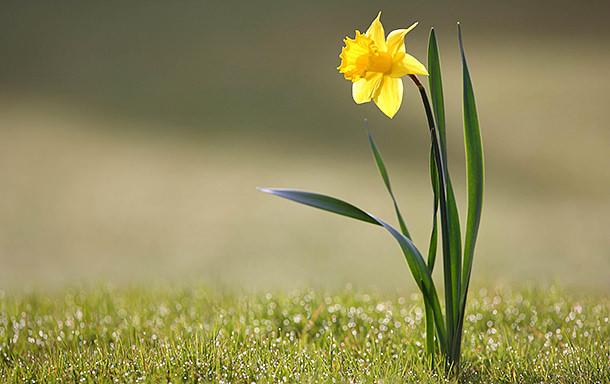
Just when you thought the snow would never melt, or the winds would never stop, daffodils brighten your garden with a burst of color in spring. Super easy to grow in most zones, daffodils are great cut flowers, can be used in both formal and informal gardens, can be grown in containers, and can even be forced to bloom out of season! There are many more varieties than just the time honored sunny yellow, and single and double foliage. There are even miniature daffodils, perfect for making a statement in a small garden, planting in a casual lawn of grass, or using in containers. If you know how to dig a hole and be patient, you can grow daffodils.
Daffodils must be planted in the fall to bloom in the spring with just a few easy care requirements.
How to Plant and Grow Daffodils
Choosing Bulbs and Varieties
Choose healthy bulbs by looking for bulbs that are papery, not shriveled. Full, heavy bulbs that don’t have gashes or cuts are a good sign of bulb health. Don’t buy any bulb with mold or fungus.
Most varieties will bloom wherever there is a winter frost, as they need a period of cold dormancy to force blooming. There are varieties that grow in the south in zone 9, check with your local nursery for best suggestions for your area. According to ‘Southern Living’, these types are perfect for Southern gardens. ‘Avalon’, ‘Carlton’, ‘February Gold’, ‘Geranium’, ‘Hawera’, ‘Ice Follies’, ‘Jack Snipe’, ‘Jetfire’, ‘Minnow’, Narcissus odorus, ‘Quail’, ‘Saint Keverne’, ‘Salome’, ‘Tête-à-tête’, ‘Thalia’, and ‘Trevithian’.
Varieties run from two foot tall sunny yellow traditional daffodils, to tiny little minis, to white doubles with a pure pink throat. There are pale yellows, coral throated beauties, and even a pure pink variety! Check out our favs at the end of the post to help you choose. Remember, choose for your space. Don’t expect a dozen minis to make a big impact on an acre lot.
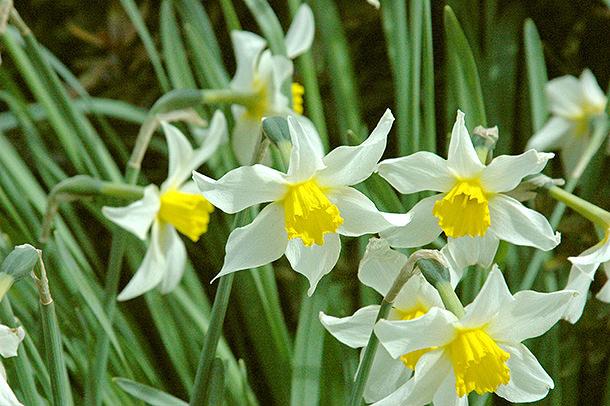
Planting
Daffodil bulbs are planted in the fall, before the ground freezes. It’s best to plant them as soon as you can get your hands on them to give them time to set out roots.
Choose a light soil, they hate heavy clay. (Don’t we all?)
Plant 3 times deeper than their height. So if your bulb is 2 inches tall, you need to plant them 6 inches deep. 3-6 inches apart, depending on size, larger bulbs farther apart.
Choose a full to part sun position. Pink and red varieties have better color with afternoon shade, but all prefer 6 hours of sun a day for best flowering.

Seasonal Care
Fall
Plant bulbs and water well. Water occasionally if the fall is dry. Add a bulb fertilizer at time of planting and each fall after that to help the plant store energy for blooms. Bone meal is a good organic food for bulbs, especially in the planting hole.
Spring
Water the bulbs if it has been dry, and a half strength liquid fertilizer at this time can boost bloom.
Summer
Do not cut back withering foliage until it has totally died back, like most bulbs. They need every last bit of the green energy to store away enough for next seasons blooms. Most gardeners plant perennials or annuals near the bulbs so that as they grow in the spring, they cover much of the aging foliage. Cut back foliage to the ground when it it totally browned.
Winter
Daffodils are very hardy and do not require being dug up for winter. You may mulch to prevent them from being displaced by the heaving ground at hard freezes. Remember to remove the mulch in spring.
Tips and Cautions
Daffodils are poisonous if eaten, so do not plant where young children or pets can access them.
The flowers will tend to face the sun, so make sure you keep that in mind when choosing your site. You don’t want all those gorgeous blooms with their backs to you all day!
Daffodils can be lifted and divided with a sharp spade in early fall as they multiply, and then replanted for a larger display next year. Most can be divided every 3-4 years.
Daffodils are deer resistant.
Our Favorites
Our selections here are from ‘Brecks‘, as they are our favorite online bulb supplier. Nope, they did not sponsor this post, we just love ’em!
‘Carlton‘
A traditional yellow, medium sized bulb, these thrive just about anywhere, and naturalize beautifully! And they have a vanilla scent!

‘Mount Hood‘
A tried and true pure white variety. Large blooms great for cutting.
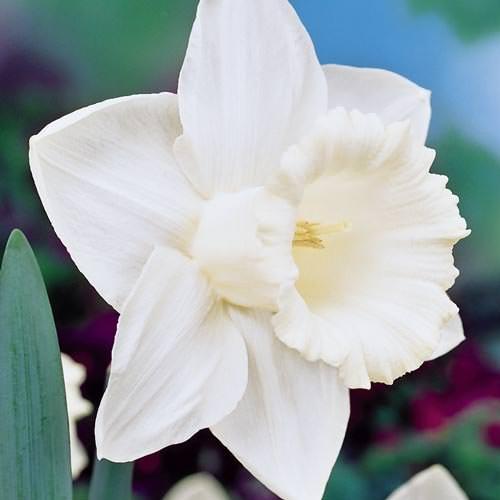
‘Cotinga‘
We love pink daffodils, and Cotinga has white petals with a pink throat. This is a smaller one, less than 12 inches high, but the long throat and delicate translucence to the petals make this an elegant choice.

‘Riot‘
Need a little more color from your Daffys? Try Riot for its red cups against white petals. Medium sized at 16 inches and very weather resistant, these are a great choice for grabbing attention for your garden!

‘Dick Wilden‘ aka ‘Golden Beauty’
This stunning double yellow daffodil is a focal plant, to be sure. Medium height, easy to grow. Gorgeous in a vase!

‘Bravoure‘
One of the most awarded daffodils, Bravoure is a great blend between a traditional happy yellow, tempered with a true pure white, and long elegant cups. Medium sized.
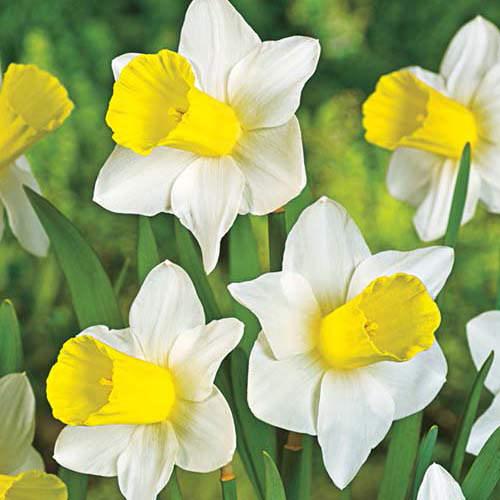
‘Petit Four‘
Tall, fragrant, beautiful.

‘Tête-à-Tête’
This is the double version of the iconic Tête-à-Tête mini daffodil, and we love this! Perfect for pots at only 8 inches high, this is a lot of bloom packed into a tiny plant! The original Tête-à-Tête is not double, but just as sweet!
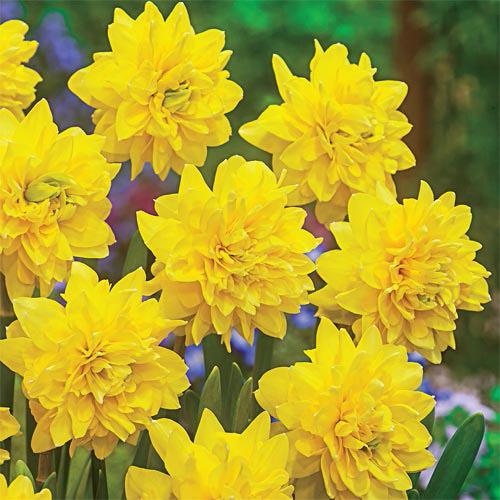
‘Salome‘
Our last choice is Salome for it’s apricot throats and pure white petals… These are medium plants that look amazing en masse. And they are fragrant!
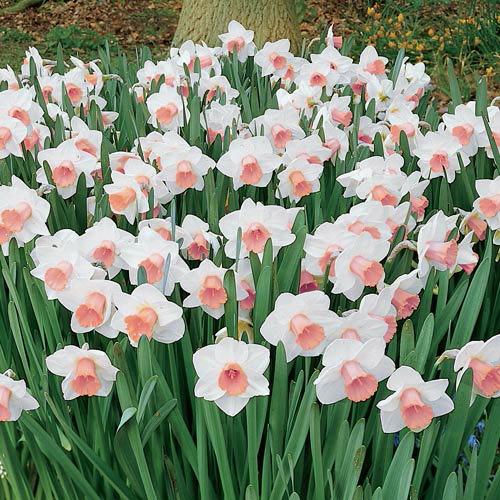
2
2



